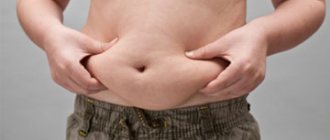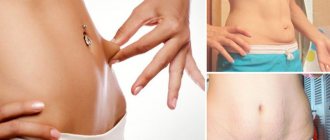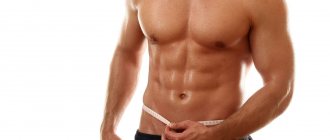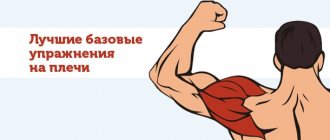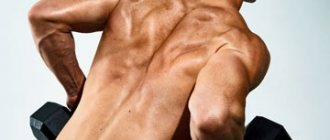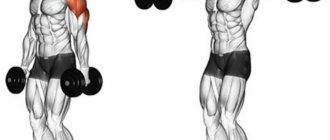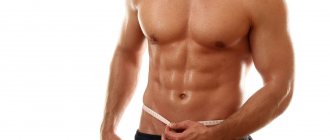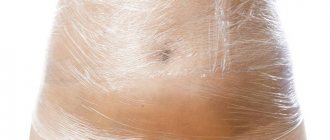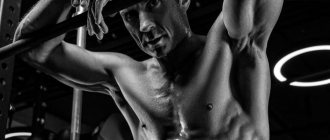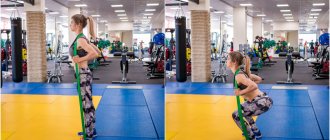Why do “sides” appear in men?
A “lifebuoy” at the waist can occur not only in women, but also in men (although somewhat less frequently).
Why? There are several reasons for this. The main reason is considered to be hormonal imbalance and decreased production of testosterone, which prevents the accumulation of subcutaneous fat.
The accumulation of visceral fat (it covers the internal organs) can also increase your waist circumference. Its growth may be caused by increased production of the hormone cortisol.
Poor nutrition and a sedentary lifestyle can also lead to increased fat on the sides of men. You can determine why your stomach and sides are far from ideal using this diagram.
What it is
Body type or somatic constitution is a definition of the physical characteristics of a person's body. This is not only the physique itself, but also a program for its development in the future.
The body can change several times throughout life, but the somatotype is determined genetically, it goes hand in hand with a person from birth to death. Any influence on the figure, be it sports, age-related changes or the consequences of diseases, only changes the outline of the body, but does not have any effect on the somatotype.
How to remove fat from the sides of a man: nutrition
Correcting your diet is one of the main steps towards a toned body. “It doesn’t matter whether you need to lose weight or gain weight, 70% of success in this matter will depend on nutrition,” explains Ruslan Panov , expert methodologist at X-Fit in Russia.
You don’t need to go on a strict diet, just “improve” your diet: reduce the amount of simple carbohydrates (sweets, snacks), increase the amount of protein (meat, fish, legumes), fiber (vegetables and fruits). It will also be useful to slightly reduce the caloric intake of your menu to start the weight loss process. You can calculate the power supply plan for your tasks using this diagram.
It is also important to drink more plain clean water, reduce the consumption of sugary carbonated drinks and alcohol.
Main types
It is customary to roughly divide people into different body types, where three key categories can be distinguished:
- An ectomorph is a person who tends to be thin.
- A mesomorph is a person with an athletic build who has muscles gifted by nature.
- An endomorph is a person who is prone to gaining excess weight.
His future athletic success will depend on what type of figure a person has.
Ectomorph
This category of people describes guys with a thin build. Typically, ectomorphs have narrow wrists and ankles, as do their hips and waist. They cannot boast of muscle mass, and they have virtually no fat accumulation. This figure is often called skinny.
Ectomorph people have a fairly fast metabolism. The main problem is that it is quite difficult for a thin person to gain muscle mass. Due to a fast metabolism, all calories eaten are quickly burned, and therefore people with this type need to consume as many calories as possible. It is recommended to include vitamins, protein shakes, mass gainers and omega-3 fats.
The main advantage is the absence of any problems with excess weight. Drying muscles is easier compared to mesomorphs and endomorphs.
You can take a closer look at this type of figure and give it an assessment in the photo.
Mesomorph
People with this figure have a massive skeleton and an athletic or average build. It is easier for them to build muscle, unlike ectomorphs.
Peculiarities:
- good metabolism;
- If you have fat deposits, you can easily get rid of them by following proper nutrition.
- good muscle growth during training.
The muscles of this type of people respond well to power loads and their rapid growth is felt, especially among beginner athletes. But if you don't pay enough attention to nutrition, you can gain excess weight. In this case, you will need to add cardio training to get rid of accumulated fat so that the man has an athletic appearance.
Endomorph
People with this figure have a round, wide and soft, dense physique. As a rule, they are short in stature. The length of their arms and legs is short. These people naturally have strong legs, due to which they can show good results when training the lower body.
Peculiarities:
- slow metabolism;
- wide hips, similar waist and shoulders;
- short legs;
- If you eat incorrectly, you will quickly gain excess weight.
Endomorphs can easily gain the required muscle mass through training. But along with muscles comes an increase in body fat, and because of this, they appear obese in appearance. In order to gain as little fat as possible, you should pay due attention to cardio training, and also do not forget about proper nutrition, monitoring the total calorie content of your food.
Remove fat from the sides of a man: workouts
The best “liquidator” of fat on the sides in men is not considered to be strength training. “Cardio and interval training are most suitable for burning fat, both subcutaneous and visceral,” explains Ruslan Panov. — After interval training, there is a period when calories are actively burned. Plus, they save time: in half an hour of training you will achieve more than in an hour and a half session of low intensity.”
You shouldn’t work your abs “until you drop”: you won’t be able to remove fat with local exercises. It is important to start the process of weight loss throughout the body and focus on working out and strengthening the abdominal and side areas. It will also be useful to move more in general to stimulate your metabolism.
It is optimal to exercise 4-5 times a week, combining cardio and interval training.
Light sexy stubble
All the girls say in unison that they really like men with light stubble. They find them sexy and attractive. And men themselves are not against this kind of decoration.
The most important thing is to provide the bristles with proper care. It should be neat and not make you feel like you just forgot to shave.
It also became known that beautiful ladies consider such men aggressive. They see them as hunters, which haunts the female fantasy.
How to remove fat from the sides of a man: a set of exercises
Which workout to choose for doing at home? We asked Ruslan Panov to compose and show us a set of exercises against waist fat in men.
“These are functional exercises, they perfectly work the muscles of the central part of the body. The transverse abdominis muscle, which is responsible for the volume of the abdominal cavity, is involved. Plus, if the muscles are in good shape, they will give beautiful outlines to this area, says Ruslan Panov. — If you work with the correct technique, then there are no particular contraindications. Moreover, the exercises are designed in such a way that they will form a healthy position of the spine and relieve back pain.”
If you have problems with your knees, you should consult your doctor before starting training.
How to build a workout
- Start your session with a short warm-up, this is important to prepare the body for stress and protect against injury.
- Build your training on a circuit basis. “You can work both for time and for the number of repetitions,” says Ruslan Panov. — If you are working against time: perform each exercise for 60-120 seconds , depending on your capabilities. Or about 20 repetitions ."
- Perform 2-3 circles in one session. “Start with two circles and over time increase the load according to your capabilities,” comments Ruslan Panov.
- Vary the pace from session to session. “For example, do two workouts doing the exercises at a slow pace, and the next one at a fast pace, this will be good for the muscles,” adds Ruslan Panov.
- Do this program 4-5 times a week . If your fitness schedule includes other intense workouts, performing exercises of this complex 2-3 times a week is enough.
To perform the exercises, you only need a mat.
Tilts
1-bends
Stand straight, feet shoulder-width apart. Place your arms along your body, maintain the natural position of your lower back, do not increase the arch in it, and do not slouch. Keep your abdominal muscles toned. Gently lean your body to the right, sliding your right hand down your thigh. Do not lean your body back or forward, try to move your body in the same plane. Then return to the starting position and do the same on the other side. This is one repetition. Do 20 of these or a maximum of 60-120 seconds .
Squats with crunch
2-squats with rotation
Stand straight, feet shoulder-width apart. Place your palms behind your head. Working your abdominal and leg muscles, move your pelvis back and squat. At the same time, twist your body to the left and try to touch your right elbow to your left knee. Watch the position of your lower back (it should be motionless, only the thoracic spine moves), do not slouch. Then return to the starting position and do the same on the other side. This is one repetition. Perform 20 of these repetitions or a maximum of 60-120 seconds .
Bent Lunges
3-lunge with twist
Stand straight, feet shoulder-width apart. Step your right foot forward, bend your knees to a right angle and lower into a lunge. At the same time, smoothly bend your body to the right, feeling a stretch in the side surface of the body on the left. Move your body in one plane, without leaning forward or leaning back. Return to a vertical position, straighten your knees and step forward with your left foot. Do the same on the left side. This is one repetition. Perform 20 of these repetitions or a maximum of 60-120 seconds .
Tilt with twist
4-tilt with twist
Stand straight, feet shoulder-width apart. Step forward with your right foot and transfer your body weight to it. Place your left foot on your toes, knee slightly bent. Place your hands behind your head, elbows bent. Lean your body forward slightly, actively working your abdominal and core muscles. Do not increase the arch in the lower back, do not slouch. In this position, smoothly twist your body to the right, at the same time straighten your left arm and reach it towards your right foot. Return to the starting position. This is one repetition, do 20 of these repetitions in each direction. Or your maximum in 60-120 seconds .
Squat Rotation
5-rotation squat
Stand straight, feet shoulder-width apart. Bend your knees, move your pelvis back (do not arch in your lower back) and lower yourself into a squat. Make sure that your knees do not go beyond the projection of your toes. Stretch your arms in front of you, clasp your palms together. From this position, smoothly twist your chest to the left, moving your arms and gaze as far to the left as possible. Then - to the right. Actively work your abs, obliques and thighs. Don't hold your breath. Return to the starting position. This is one repetition. Perform 20 of these repetitions or a maximum of 60-120 seconds .
Plank rotation
6-rotation plank
Take a lying position with emphasis on your forearms and toes. Stretch your head forward and your feet back. Turn your body so that you rest on the sides of your feet and left forearm. Stretch your right arm up. Try to keep your body in one straight line - do not bend at the lower back, do not move your pelvis forward or backward. From this position, lower your right arm down, moving your right palm under your left side, and twist your body down and to the side. Actively work your abdominal muscles, oblique abdominal muscles and leg muscles. Don't slouch or arch your lower back. Return to the starting position. This will amount to one repetition, perform 20 such repetitions in each direction.
Crunches with rotation
7-crunches with rotation
Sit on the floor with your legs straight, cross your arms over your chest. Bend your knees slightly. Using your abdominal muscles, lean your body back. As you move your body down, twist it to the left to touch the floor with your left side. Then smoothly return to the starting sitting position. Lean your body back again and, lowering to the floor, twist to the right, touching the mat with your right side. This is one repetition, do 20 of these or a maximum of 60-120 seconds .
Diagonal crunches
7-press crunch
Lie on your back, lift your legs up, point your feet towards the ceiling. Working your abdominal muscles, lift your shoulders, neck and head above the floor. Twist your body up and to the left, reach your right hand towards your left foot. Then, without lowering your shoulders to the floor, twist your body up and to the right, reaching with your left hand towards your right foot. This will amount to one repetition, perform 20 such repetitions in each direction or a maximum of 60-120 seconds .
"Climber" with rotation
8-plank crunches
Get into a plank position with your arms straight. Stretch your head forward and your feet back. Place your palms under your shoulders. Twist your pelvis to the right, bend your left knee and pull it forward and to the right, towards your right elbow. Actively work your obliques, abs, leg muscles and core. Then return to the starting position with your feet together. After this, twist your pelvis to the left, bend your right knee and point it towards your left elbow. Return to the starting position. This is one repetition, complete 20 of these repetitions or a maximum of 60-120 seconds .
After completing the last exercise, rest for a minute and start all over again. Perform 2-3 laps per workout. Exercise according to this scheme regularly to make your abdominal muscles more toned and your silhouette more harmonious.
Narrowing waist
This operation is most often accompanied by other plastic surgeries - breast augmentation, abdominoplasty or liposuction in the abdomen or waist. The degree of waist narrowing is determined personally with the patient and the doctor at a preliminary consultation. During a consultation with a plastic surgeon, the scope of the operation is precisely agreed upon according to the patient’s wishes.
The operation is performed under general anesthesia. The duration of the operation itself to create a narrow waist is about 40-50 minutes. In case of combination with other plastic surgeries, it lengthens. A prerequisite for this operation is a preoperative computed tomography of the chest and abdomen with reconstruction of the bone skeleton. This study will allow you to accurately mark and determine the levels of the XI and XII ribs on both sides.
In the operating room, after tracheal intubation and fixation of the endotracheal tube, the patient turns over from his back to his stomach. Next, at the previously designated points of location of the XI and XII ribs, an incision is made into the skin and soft tissues in the projection of the bends of the ribs. The ribs are mobilized one by one from the thickness of the muscles, carefully, without damage, the intercostal neurovascular bundle is isolated and retracted down. Next, with a special tool - an oscillating saw - an incision is made into the dorsal outer plate of each of the XI and XII ribs. At the next moment, the surgeon applies pressure through the thickness of the tissue to the free ends of the previously osteotomized ribs, thereby breaking the inner cortical plate of the rib, which remains connected by the periosteum and connective tissues on the inside of the ribs. Confirmation of the adequacy of the technique performed is a significant increase in the mobility of this area and intraoperative radiography.
Next, the surgeon performs hemostasis, layer-by-layer suturing of the wound with the application of an intradermal suture. The operation is repeated on the opposite side.
Immediately after applying aseptic dressings to the postoperative sutures, a lumbar corset is put on the patient’s body. A wide (at least 7 cm) leather belt is placed on top of the corset along the patient’s waistline and tightened. The duration of wearing this design is at least 1 calendar month (preferably 2 months) and is determined by the timing of the formation of callus in the area of broken ribs.
Comparison of preoperative and postoperative photographs, as well as objective measurements before and after surgery, allow us to objectify (prove) the result of the operation - waist reduction.
An important feature of this aesthetic operation is that it is less traumatic compared to operations to narrow the waist, when the 11th and 12th ribs are removed: the operation is performed through small incisions up to 3 cm without removing the ribs. The ribs are preserved, the waist narrows, and the ribs moved in this way continue to perform frame and protective functions, and are also the attachment points for a large number of muscles of the human body.
Main types of male figure
It is believed that the division into body types is a convention, because most often the proportions of the body can be corrected by performing various physical exercises. Using a simplified classification, it is possible to determine what needs to be emphasized in oneself and what needs to be hidden as a flaw.
There are 4 types of male figure:
- triangle;
- trapezoid;
- rectangle;
- oval.
Triangle
This type includes men with broad shoulders and a narrow pelvis. The waist is placed in line with the hip or slightly wider. Men have developed latissimus and teres dorsi muscles. Most often, people belonging to this type engage in athletics and swimming. The same form can be achieved through training in the gym.
Trapezoid
An analogy can be drawn with a triangle for this type of figure in men. Characteristic differences are: powerful arms, large muscles and a wide body, stocky build. These people are often overweight.
Rectangle
The characteristic features of this type of figure in men are that the shoulders, hips and waist are located at the same level. In this case, the shoulders may be slightly wider than the hips, but they do not look massive. Typically, men look thin and have trouble gaining weight.
Oval
This type of figure includes all men who are overweight. It is worth noting that the type of fullness can be different: “hourglass” with a pronounced waist; weighted bottom; the figure is rectangular or triangular; men have a protruding belly.

